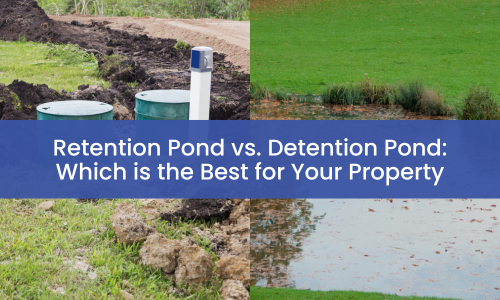Retention ponds and detention ponds essentially do the same thing, which is improve drainage, but the difference is in the details. If any of the following are true about your project, a detention pond makes more sense:
- Your property is smaller
- It needs to stay as dry as possible
- Water quality isn’t a concern
On the other hand, if any of the following are true, a retention pond is the right choice:
- Your property is large
- Property value or aesthetics are a concern
- Water quality is a concern
Here is a closer look at retention and detention ponds and how they benefit a property.
The Differences Between a Retention Pond and Detention Pond
A detention pond is a piece of earthwork construction that traps stormwater runoff during heavy rainfall events. Unlike a retention pond, detention ponds are designed to drain completely between rainfall events. That means when the weather changes, so does their appearance. During the dry season, detention ponds can blend in with the surrounding landscape. When it’s wet, their water levels will rise and fall rapidly.
Detention ponds are a drainage feature only, graded with a gentle slope that leads into a riser and culvert network. There may be additional outlets at the bottom of the detention basin as well. It Is important to keep detention basins clear of debris, as it will collect at the bottom of the pond and be exposed once the pond drains.
Retention ponds retain water and therefore maintain a minimum water level throughout the year. As such, they can serve as natural habitat and support the local ecosystem, which may be bonuses for your organization.
Retention ponds are typically built with a spillway for intense flooding, but most water drains via vegetation or evaporation. They may be considered an amenity and boost property values in some areas. If your property has the space, a retention pond can provide long-term value.
Retention and Detention Ponds Require Extensive Planning
Site development contractors are experts in retention and detention pond construction, as both projects call for significant dirtwork.
Both projects also require detailed planning. As such, the following elements must be considered in the design of the retention or detention pond:
- How much water the pond is expected to take on during a typical rainfall event
- The pond’s volume, or capacity
- How quickly the pond must be able to drain
- Access to the pond, including road access and maintenance access
- How overflow will be handled, either with a spillway or additional riser system
- Embankment placement and slope
- How debris will be trapped before entering drainage structures
- The type of vegetation that will be placed around the pond
- The presence of nearby foundations and other structures
There is a lot to consider when digging out a retention or detention pond, which is why commercial property owners turn to experienced site developers to manage their stormwater project.
Reputable site developers have structural engineers on their staff, capable of drawing up precise site plans that account for the above factors. This is the only sure way to create a detention or retention pond that meets safety, drainage, and compliance needs.
Maintenance is Essential for a Detention or Retention Basin
Retention and detention ponds don’t have complex maintenance needs, but they do require regular upkeep to ensure they look and function properly.
This maintenance includes:
- Controlling vegetation growth around the pond’s perimeter, including trimming and mowing
- Clearing out any debris from the pond and any drainage structures
- Regularly inspecting drainage structures like the riser and outlets for wear or damage
- Stabilizing the pond’s slopes and ensuring erosion controls are in place
As earthwork structures, retention and detention ponds can last a long time with basic maintenance, but regular upkeep ensures efficient drainage. Debris and sediment can quickly clog up drainage structures if they are not inspected often. Pests may move in and take over if vegetation isn’t controlled. To get an optimal return on your retention or detention pond investment, don’t neglect it after installation.
Partner with a Reputable Site Developer for a Retention or Detention Pond Installation
Retention and detention pond projects both represent major alterations to your commercial property. They take up a lot of room and greatly alter the way stormwater runoff is managed on your property. Retention and detention ponds can influence your property’s value. They can be attractive amenities if properly maintained, or an eyesore if they are not.
Given their impact and scale, retention and detention pond projects should only be trusted to experienced site developers. Look for a local team that has handled projects similar to yours, as every area poses its own site development challenges.
In the Houston area, for example, detention requirements are a matter of constant debate. In 2021, the city voted to expand detention capacities for large residential properties, a sign that Houston is prioritizing better stormwater management.
A site developer with local experience will ensure your retention or detention pond is not only built with your property’s drainage needs in mind, but also while observing safety and compliance standards.
- HOA & Condos – How Asphalt Pavement Can Affect Your Houston Property Values - March 6, 2025
- What Certifications or Licenses Should a Houston Asphalt Contractor Have? - September 17, 2024
- Common Challenges in Concrete Construction - September 11, 2024

